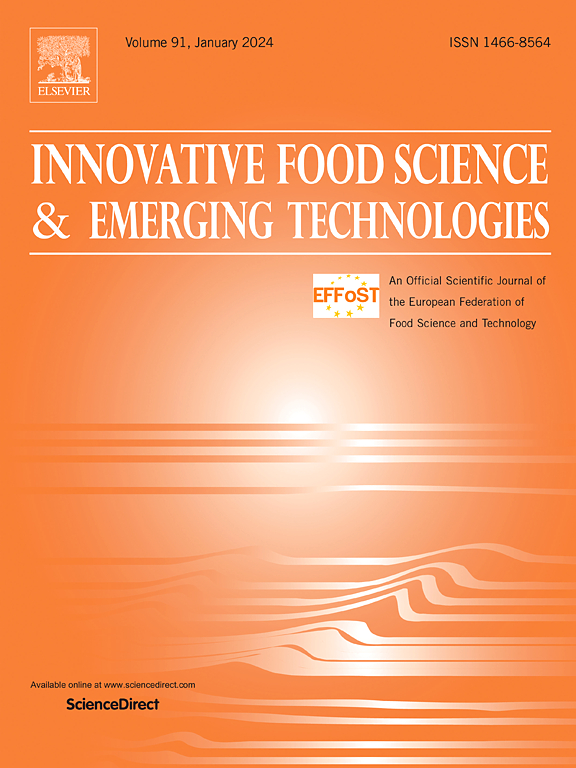Magnetic field-mediated heating: An effective approach for regulating the thermal aggregation behavior and gelation properties of low-salt myosin
IF 6.3
1区 农林科学
Q1 FOOD SCIENCE & TECHNOLOGY
Innovative Food Science & Emerging Technologies
Pub Date : 2025-07-19
DOI:10.1016/j.ifset.2025.104120
引用次数: 0
Abstract
The study aimed to elucidate the underlying mechanism of magnetic field-mediated heating (MFMH) treatment on the thermal aggregation behavior of myosin under low-salt conditions. The dynamics of myosin aggregation and gelation properties formed at different heating temperatures were investigated under conditions with and without magnetic field treatment (3.8 mT). The results demonstrated that applying a magnetic field during heating notably decreased the turbidity of myosin, particularly at 60 °C, where it decreased from 0.66 to 0.58, exhibiting a noticeable delay in thermal aggregation. Meanwhile, magnetic field treatment (3.8 mT) led to a substantial reduction in myosin particle size, which promoted the subsequent formation of an ordered protein aggregation. Structural analysis indicated that the intervention of magnetic field facilitated the shift from α-helix to β-sheet, which enhanced the development of a well-organized gel network structure. PCA analysis results further validated this finding. Moreover, the surface hydrophobic characteristics of myosin were reduced (a substantial decline of 9.08 %), while disulfide bond was enhanced from 0.73 to 1.03 g/L (65 °C), promoting cross-linking in the head region of myosin. Intermolecular force results indicated that magnetic field mediation significantly enhanced ionic bonds while reducing hydrophobic interactions during the thermal aggregation of myosin. It can be seen that magnetic field can improve the gel properties of myosin by regulating its thermal aggregation process, and magnetic field treatment may be a potential physical method to improve the quality of low salt gel meat products.
磁场介导加热:调节低盐肌球蛋白热聚集行为和凝胶特性的有效方法
本研究旨在阐明低盐条件下磁场介导加热(MFMH)处理对肌球蛋白热聚集行为的潜在机制。在有磁场和无磁场处理(3.8 mT)的条件下,研究了不同加热温度下形成的肌球蛋白聚集和凝胶特性的动力学。结果表明,在加热过程中施加磁场可显著降低肌球蛋白的浊度,特别是在60°C时,其浊度从0.66降至0.58,表现出明显的热聚集延迟。同时,磁场处理(3.8 mT)导致肌球蛋白颗粒大小大幅减少,这促进了随后有序蛋白质聚集的形成。结构分析表明,磁场的干预促进了α-螺旋向β-片的转变,促进了凝胶网络结构的形成。PCA分析结果进一步验证了这一发现。此外,肌球蛋白的表面疏水特性降低(显著下降9.08%),而二硫键从0.73 g/L增强到1.03 g/L(65℃),促进了肌球蛋白头部区域的交联。分子间作用力结果表明,磁场介导显著增强了肌球蛋白热聚集过程中的离子键,减少了疏水相互作用。由此可见,磁场可以通过调节肌球蛋白的热聚集过程来改善其凝胶性能,磁场处理可能是一种潜在的提高低盐凝胶肉制品质量的物理方法。
本文章由计算机程序翻译,如有差异,请以英文原文为准。
求助全文
约1分钟内获得全文
求助全文
来源期刊
CiteScore
12.00
自引率
6.10%
发文量
259
审稿时长
25 days
期刊介绍:
Innovative Food Science and Emerging Technologies (IFSET) aims to provide the highest quality original contributions and few, mainly upon invitation, reviews on and highly innovative developments in food science and emerging food process technologies. The significance of the results either for the science community or for industrial R&D groups must be specified. Papers submitted must be of highest scientific quality and only those advancing current scientific knowledge and understanding or with technical relevance will be considered.

 求助内容:
求助内容: 应助结果提醒方式:
应助结果提醒方式:


